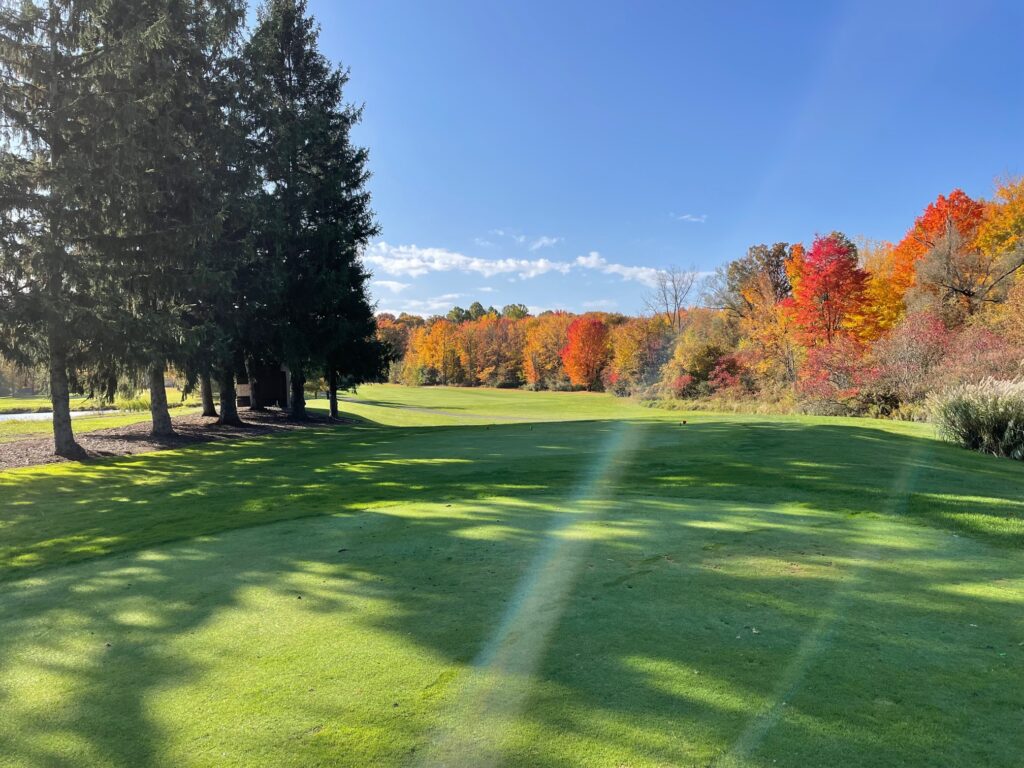The high draw in golf with irons is often a desired shot.
The best golfers are able to hit a variety of shots and many amateurs set out to one day hit a consistent draw.
Most golfers begin their journey hitting a fade or slice and then eventually learn to turn it over.
Eventually, the best golfers learn to shape the ball in different directions and at different heights. There are six key shots to a complete golf game:
- High draw
- Medium draw
- Low draw
- High fade
- Medium fade
- Low fade
Depending on the undulation and the location of the pin, different shaped shots are key at different times. Some great golfers have played a high level of golf with only 1 or 2 of the 6 shot above. While others use different shots depending on how their golf swing feels.
Jack Nicklaus is known for playing the shot he has that day. I prefer to practice all 6 shots to help keep the swing path from getting too far in one direction. My tendency is to get too far from the inside out and I actually fight the overdraw.

How To Hit A High Draw With Irons?
The golfer will want to adjust his or her setup including the ball position and then work on controlling the clubface and the swing path to produce an inside out swing path that produces draw spin.
Setup Adjustments
- Move the ball slightly forward
- Tilt slightly back
- Close the stance a touch
Moving the ball forward and slightly tilting back helps the golfer hit the ball higher. The closed stance helps produce an inside to out swing path which helps put draw spin on the ball.
Controlling the Clubface
Many golfers might think they need to close the clubface through impact. However, this is not the case. Did you know the golfer can actually hit a push draw with a clubface that is 2 degrees or more open to the target line? The reality is that as long as the swing path is right of the clubface, the golfer will hit a draw (see ball flight laws below).
Ball Flight Laws (Quick Overview):
- We know the following:
- The ball will start in the relative direction of the clubface at impact.
- The ball will curve away from the swing path.
Several Examples:
- Clubface 2 degrees right, swing path 4 degrees right (Push Draw)
- Clubface 2 degrees left, swing path 2 degrees right (Pull Draw)
- Clubface 2 degrees right, swing path 12 degrees right (Over draw or hook)
- Clubface 2 degrees left, swing path 4 degrees left (Pull Fade)
To hit a controlled draw, the golfer is going to want to have a clubface that is 1-2 degrees to the right. He or she will want to have an inside swing path that is 3-4 degrees to the right or inside to out.
The best golfers can control the clubface to keep the difference between the clubface and swing path from getting too large. The larger the gap, the more the side spin and the greater the chances of over drawing or hooking a shot.

Swing Path
In the setup, we slightly had the golfer close his or her stance. This can help promote an in to out golf swing and help the golfer start to produce a draw spin on the golf. We want to do a lot of our work in the setup and then make a natural swing and react to the shot that we need.
How To Test It Out
I would recommend hitting 10 shots and seeing what your natural ball flight is. Take note of the following:
- What direction is the ball starting in?
- What direction is the ball curving in?
If your ball starts right, your club face is slightly open, which is just fine.
If your ball starts left, your club face is slightly closed, which can make it difficult to hit a draw.
The goal here is to practice getting the ball to start to the right. Once we have accomplished this can can make some adjustments to work on the curve of the ball.
Here is a wonderful drill you can use to build a stock shot draw:
- At the driving range, set up an alignment stick about 6-8 yards in front of you, straight down your target line.
- If you have a second alignment stick, set the stick 3-4 feet right of the first stick (for a draw) or left of the first stick (for a fade).
- Complete your initial assessment see how many times out of 10 you can start the ball to the right or left of your target. Pick one side and measure your game at this point.
- The goal is to eventually get 7 out of 10 shots to start to the correct side and draw back towards the target.

My Experiences
I fought the slice for several years when I first started the game at the age of 10. Eventually, I learned to hit the push draw and eventually fought the overdraw. I practice the 6 shots above at least once a week to keep my swing balanced, to feel the different shots I might need and to challenge my shot shaping abilities.
The key for me when I was struggling to hit a draw early on in my golf journey:
- I moved more weight on the left side.
- I kept my head more centered.
- I pictured swinging on a circle and hitting the ball on the backside of the circle.
- I stopped trying to roll my hands over. (Wrongly taught to roll hands over to hit a draw for many years in major golf publications)
Final Thoughts: Hitting a High Draw with an Iron
If you are struggling to hit the ball high, look at a point up in a tree and attempt to hit the ball up into the tree, but stay within the shot. The more we can visualize shots and get out of our way with swing thoughts, the better chance we have of playing more instinctive golf.
Remember, that if we can make simple adjustments in the setup with ball position, body tilts, and closing down the shoulders, we can have a more natural swing and get the results we are seeking.
My Secret To Golf Improvement
Let’s face it, in order to get really good at golf, we must practice frequently. About give years ago, I made the leap and invested in a golf simulator build for my garage. I went with a SkyTrak Launch Monitor and the TGC software and can now play over 100,000 courses including Augusta, Pebble Beach, Bethpage Black, Whistling Straits. St. Andrews and many other of the top 100 courses in the world.
This golf simulator setup, which is more affordable that you might imagine, has been a game changer. I can now play golf everyday of the year regardless of rain, snow, cold weather or time of day. I can practice or play rounds of golf. I can stand in the 11th fairway at Augusta and with the auto-rewind feature I am able to practice my approach shots from various differences.
It is worth checking out through Rain or Shine Golf as they offer some incredible packages along with financing offers that are difficult to beat.
Some direct links to Rain or Shine Golf for pricing and financing:

